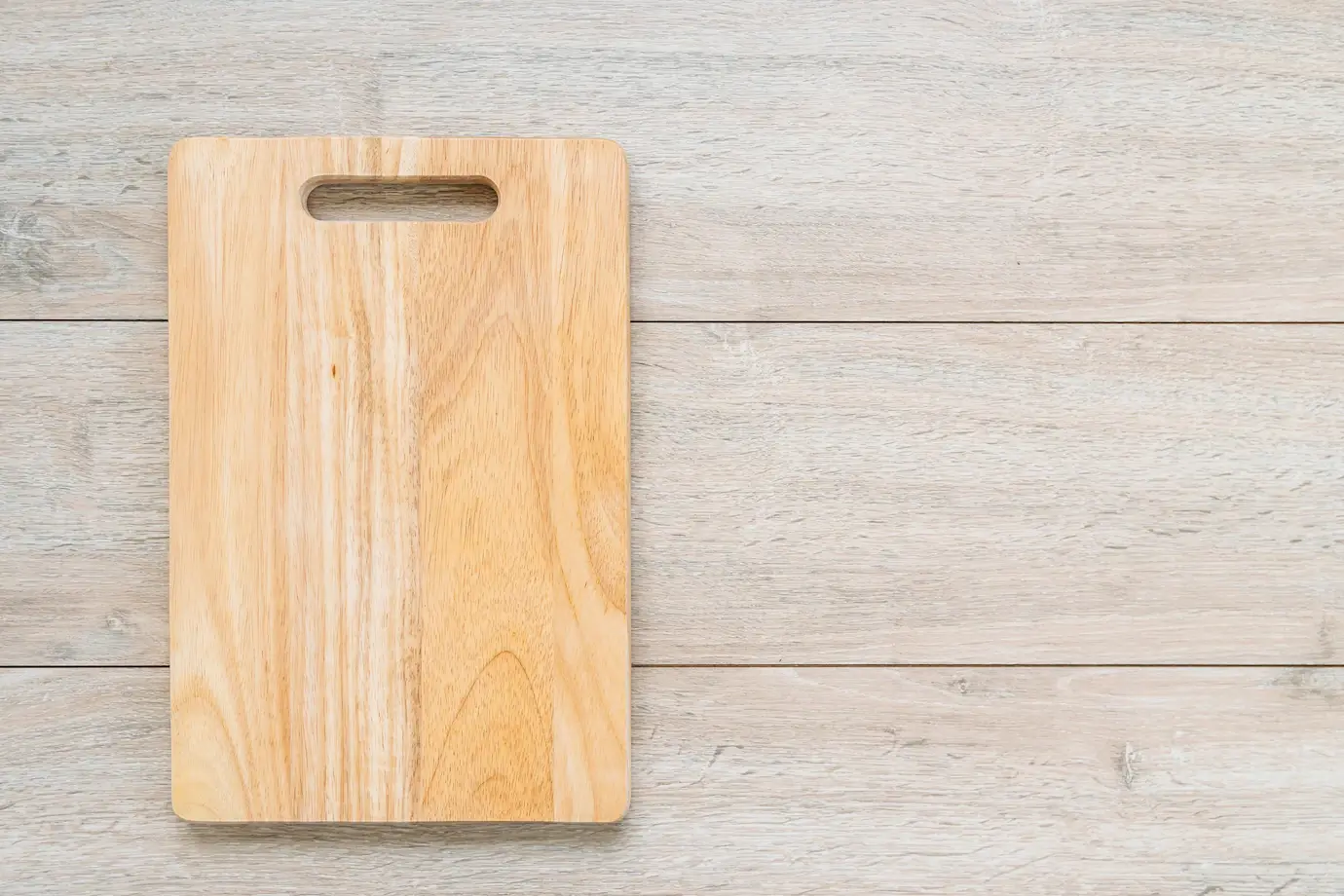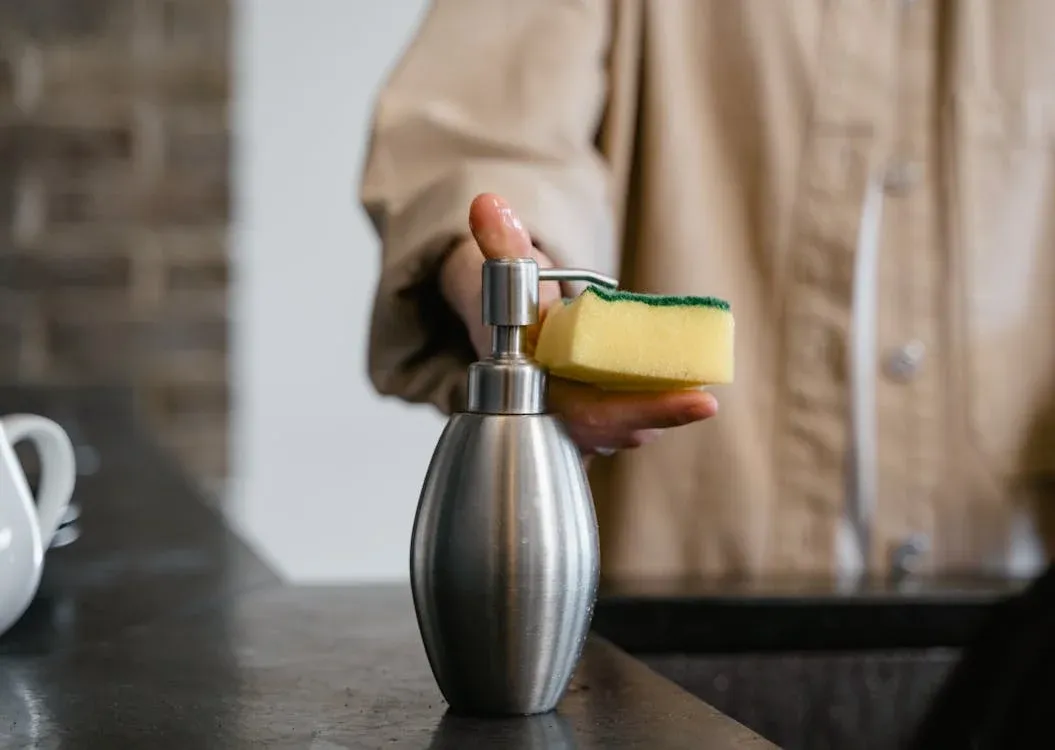Welcome to the world of kitchen superheroes – your cutting boards! These trusty sidekicks are more than just slabs of wood or plastic; they're the unsung heroes of every delicious meal you create. But wait, did you know some cutting boards can be sneaky villains, hiding nasty chemicals? No worries! We've scoured the kitchen universe to bring you the top 5 non-toxic cutting boards. They're not just safe; they're your kitchen's new best friends. Ready to chop, slice, and dice your way to healthier, happier cooking? Let's dive in!
🤝As an Amazon Associate, we earn from qualifying purchases made through our links, at ZERO additional cost to you.
5 Best Non-Toxic Cutting Boards
- Best Wood & Overall: Sonder Los Angeles: Walnut/Cherry/Maple
- Best Bamboo & Eco-Friendly: Royal Craft Wood: Bamboo
- Best Silicone: cozymomdeco Silicone Double-Sided Cutting Board
- Best Epicurean: Epicurean Kitchen Series Cutting Board
- Best Rubber: NoTrax Natural Rubber Cutting Board
1. Best Wood & Overall
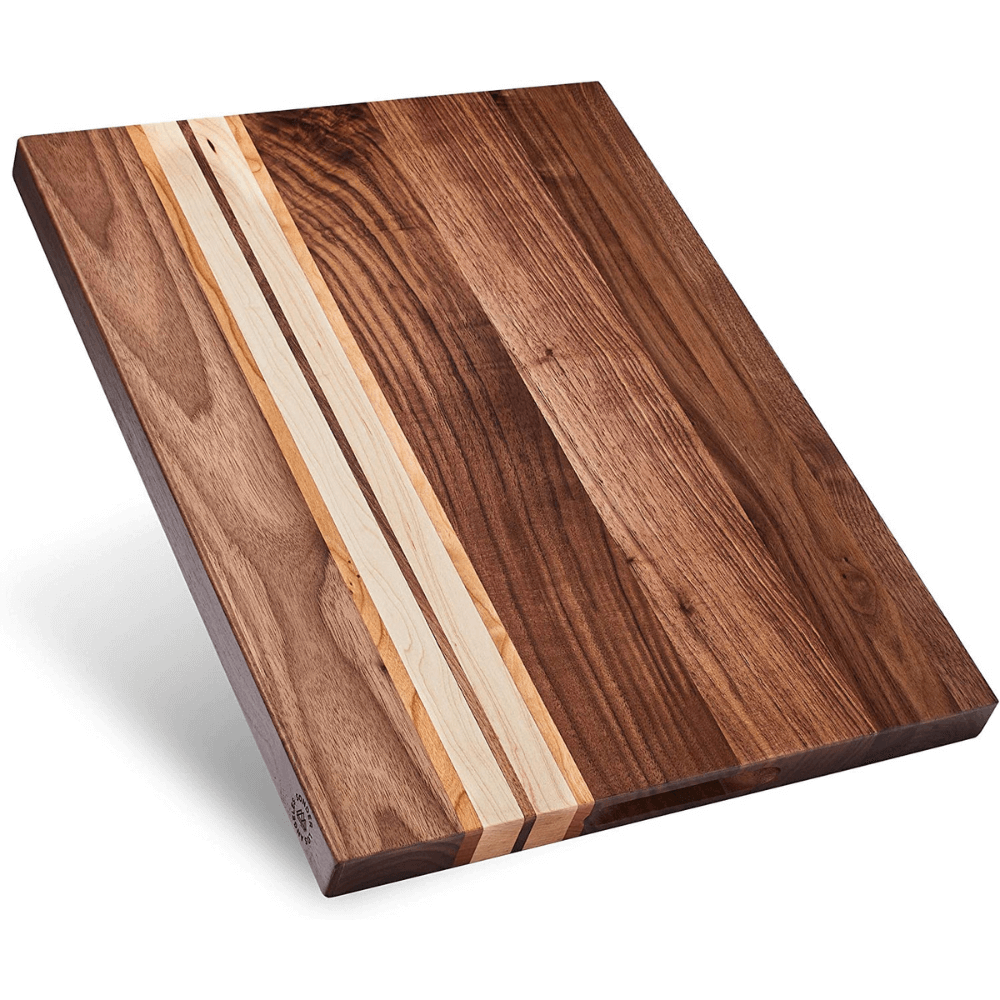
Sonder Los Angeles: Walnut/Cherry/Maple
This board is celebrated for its unique blend of high-quality woods (walnut, cherry, maple), offering both aesthetic appeal and durability. Its innovative design, including a built-in sorting compartment, and its edge grain construction for moisture and stain resistance, make it a versatile choice for both prepping and serving.
What We Love
- Tri-Wood Composition: Crafted from walnut, cherry, and maple.
- Lightweight and Durable: Weighs 5.5 pounds, edge grain construction for durability.
- Versatile Use: Reversible with a built-in sorting compartment.
- Knife-Friendly Surface: Protects and preserves knife edges.
What to Keep in Mind
- No Juice Groove: One side lacks a juice groove.
- Regular Maintenance: Requires hand washing and periodic oiling.
Why It Might Be Right for You
This board is a masterpiece for those who see their kitchen as a place of art and functionality. Its unique blend of walnut, cherry, and maple not only makes it a durable platform for your culinary creations but also a statement piece for any gathering. Ideal for the aesthetically inclined chef who demands the best in both form and function.
Customer Review (source: Amazon)
I've been using this board for over a year and a half, and it's amazing how it still looks brand new. Regular light sanding and applying butcher block oil really make a difference. It's a testament to how a little care goes a long way in maintaining its quality.
2. Best Bamboo & Eco-Friendly
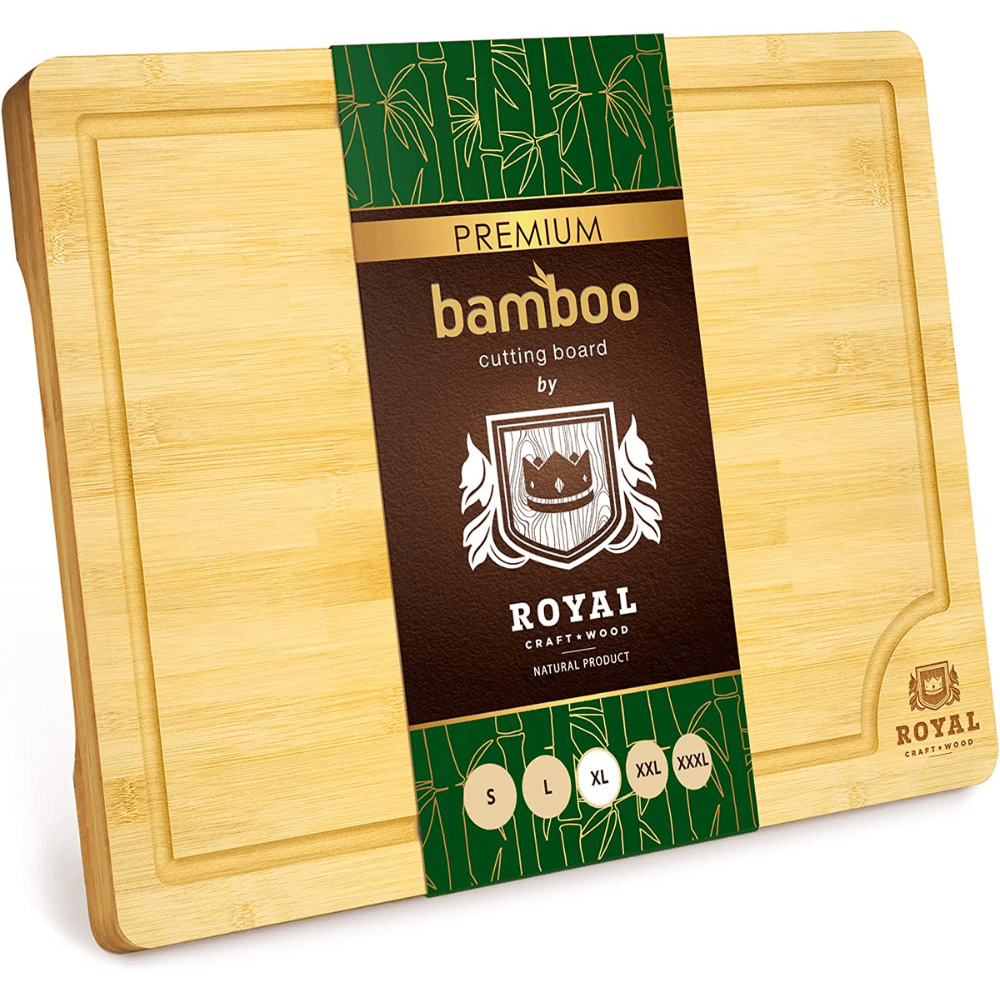
Royal Craft Wood: Bamboo
Chosen for its sustainable and natural bamboo material, this cutting board is durable, knife-friendly, and antibacterial. Its double-sided design and ease of maintenance appeal to budget-conscious and eco-aware consumers looking for quality and practicality.
What We Love
- Bamboo Material: 100% natural, durable, and antibacterial.
- Versatile Use: Double-sided design for cutting and serving.
- Knife-Friendly: Gentle on knives, preventing quick dulling.
What to Keep in Mind
- Care Requirements: Needs regular cleaning and occasional oiling to maintain quality.
Why It Might Be Right for You
If you're on a journey towards a more sustainable lifestyle without compromising on quality, this bamboo cutting board is your perfect kitchen companion. Its natural antibacterial properties and durability make it a smart choice for eco-conscious cooks who prioritize both the planet's health and their own.
Customer Review (source: Amazon)
I'm absolutely in love with this cutting board! It's the perfect balance of size and weight, fitting beautifully on my counter. Unlike others I've seen, it's neither too heavy nor too thin, just right for everyday use. The luxurious feel, combined with its affordable price, makes it a must-buy. It's well-oiled, comes with clear care instructions, and the bamboo material gives it a sleek, non-grainy finish. My family tested it too, and we're all impressed - it's lightweight and leaves no marks. A fantastic addition to any kitchen!
3. Best Silicone

cozymomdeco Silicone Double-Sided Cutting Board
This cutting board stands out for its high-grade silicone rubber construction, offering durability, safety, and double-sided usability. Its foldable design for space-saving storage and resistance to stains and odors make it ideal for both indoor and outdoor use, emphasizing kitchen efficiency and hygiene.
What We Love
- Quality Made in Korea: Crafted with top-grade silicone rubber for durability and safety.
- Double-Sided Usability: Features drip grooves and texture treatment on both sides for versatile use.
- Foldable Design: Easily foldable for space-saving storage and convenient drying.
- Great for Camping: Ideal for outdoor activities with its flexible, double-sided, and heat-resistant design.
- Stain and Stick Resistant: Maintains appearance without tarnishing or discoloring.
What to Keep in Mind
- Cutting Marks: While designed to resist, cutting marks can still occur but are less prone to harboring bacteria compared to other materials.
Why It Might Be Right for You
For the adventurous cook who loves to take their culinary skills on the road, this silicone cutting board is unmatched. Its foldable, double-sided design is perfect for those who value convenience and cleanliness, whether you're preparing a meal in your home kitchen or by a campfire under the stars.
Customer Review (source: Amazon)
I switched to this silicone cutting board from plastic because of concerns about plastic nanoparticles in our food. There weren't many options, but this one has been fantastic. I liked it so much that I bought a second one. It's easy to cut on, doesn't show knife marks, cleans up well, and is a good size. Plus, it's flexible yet firm enough to be stored upright, which is super convenient.
4. Best Epicurean
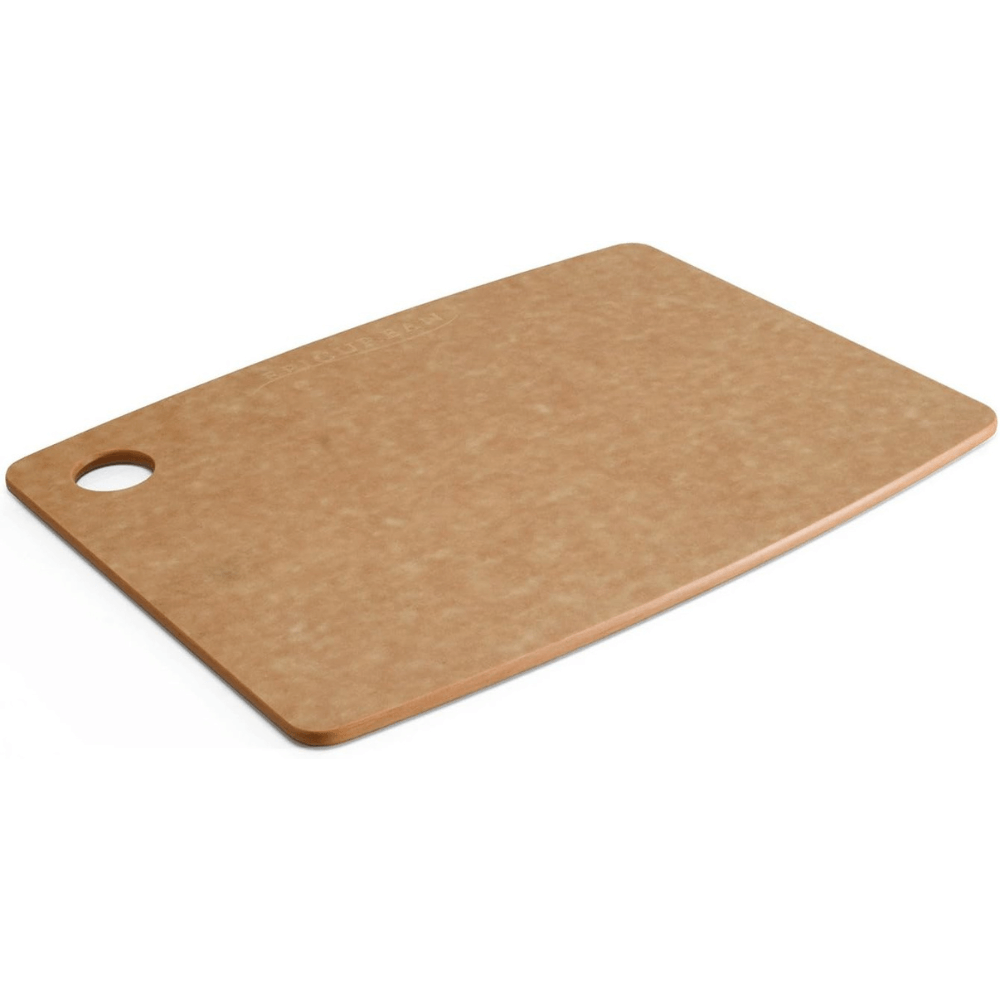
Epicurean Kitchen Series Cutting Board
Made in the USA from Richlite paper composite material, this cutting board is non-porous, lightweight, and dual-sided, making it easy to handle and versatile for all types of food preparation. Its low maintenance and ability to withstand high temperatures position it as a durable and convenient choice for busy home chefs.
What We Love
- Made in the USA: Constructed from Richlite paper composite material for durability and knife-friendliness.
- Non-Porous: Doesn't absorb liquids or odors, ensuring a clean cutting surface.
- Lightweight & Dual-Sided: Easy to handle and versatile for all types of food preparation.
- Low Maintenance: Requires no special care and can withstand temperatures up to 350°F, doubling as a trivet.
What to Keep in Mind
- Thin Profile: While advantageous for storage and handling, its slim design may not suit all cutting needs.
Why It Might Be Right for You
This board is a godsend for the multitasking chef who thrives on efficiency and durability. Its lightweight, dual-sided nature makes it perfect for quick meal prep and easy clean-up, ideal for those who love to cook but are short on time. If you're looking for a board that can keep up with your busy lifestyle, this is the one for you.
Customer Review (source: Amazon)
I've always preferred wood cutting boards but never got around to the maintenance they require, especially since we tend to wash ours in the dishwasher, which isn't great for wood. These boards are the closest thing to wood I've found, and they're dishwasher safe, which is a huge plus. They're sturdy, don't bend or warp, and don't show cuts as much as plastic ones do. We've used the larger ones for serving pizza, which works out perfectly, and the smaller ones are just the right size for the dishwasher. Our older ones have lasted 2-3 years and still look and work great, with only minor slice marks that don't affect their use at all. These are fantastic boards.
5. Best Rubber
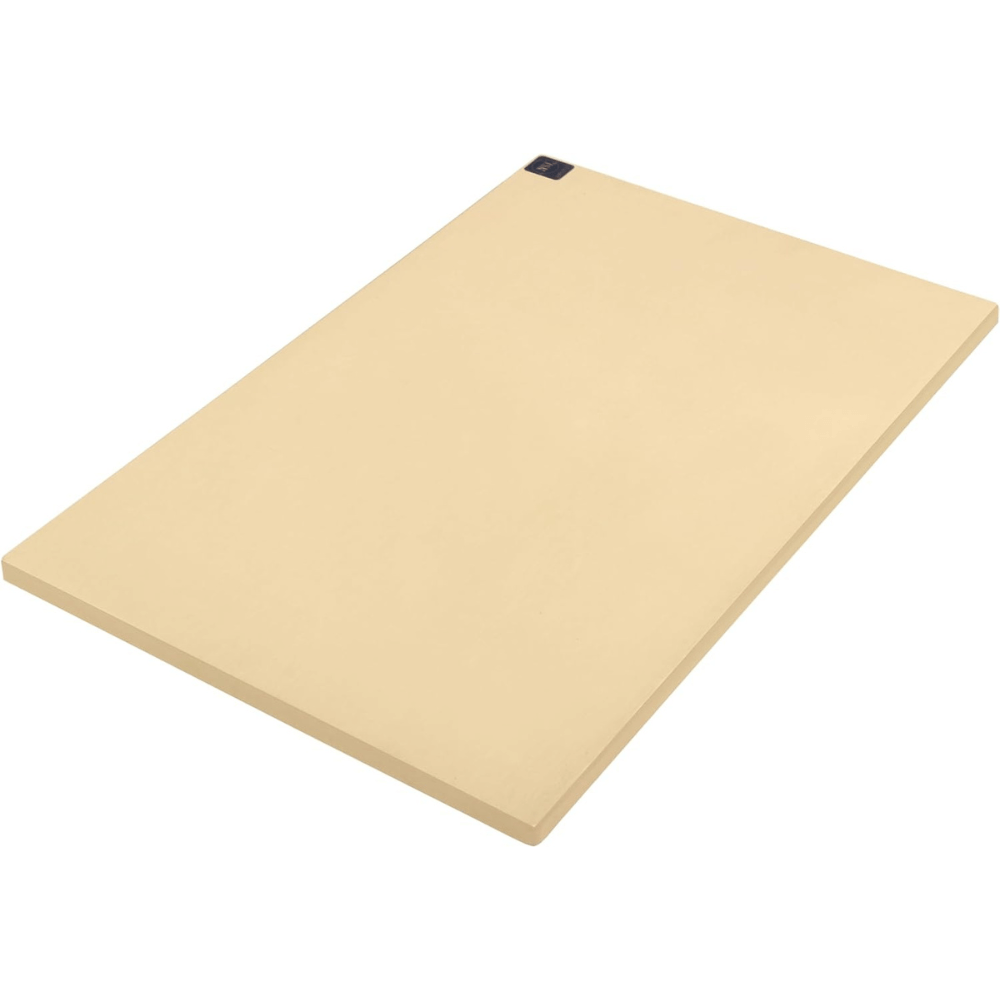
NoTrax Natural Rubber Cutting Board
Preferred for its professional-grade, high-density natural rubber that's easy on knives and can be resurfaced by sanding. Its durability, resistance to cracking, splintering, and odors, along with its non-skid property, make it a top choice for both professional kitchens and serious home cooks.
What We Love
- High-Density Natural Rubber: Will not crack, splinter, swell, or absorb liquids or odors.
- Knife-Friendly: The rubber compound preserves knife edges and prevents slipping.
- Made in the USA: Ensures quality and durability, certified by NSF International.
- Resurfaceable: Can be sanded to extend its life, offering great value.
What to Keep in Mind
- Hand Wash Only: High temperatures from dishwashers can cause warping.
- Weight and Thickness: At 0.5 inches thick, it's substantial and may be heavier than other types.
Why It Might Be Right for You:
If you're a culinary enthusiast seeking a cutting board that combines safety, durability, and maintenance ease, the NoTrax Sani-Tuff is your match. Its natural rubber composition not only protects your knives but also ensures a stable cutting experience without the worry of contamination. Perfect for those who appreciate a professional-grade tool in their kitchen arsenal.
Customer Review (source: Amazon)
I had to get creative to find the perfect size for my needs, so I ordered a larger NoTrax cutting board and trimmed it down myself with a fine tooth hand saw and a sander, which was surprisingly easy. Now, I even have a custom-sized one for the boat! It's a top-notch board but it's definitely heavier than your average small cutting board, and its size can make it a bit cumbersome to clean by hand since it's not dishwasher safe. Over time, I've noticed it retains a distinct "plastic/chemical" smell, which thankfully doesn't affect the food but does linger in the cabinet. On the plus side, a quick sanding refreshes its surface beautifully. I absolutely love this cutting board despite these few points to watch out for.
How We Chose Our Top Picks
Our mission is to give you expert-level knowledge about these products. Even if we haven't used every single one personally, we've done a lot of homework to understand them better. We've looked closely at what real users are saying, especially focusing on customer reviews from Amazon. This helps us figure out how well these products work, how long they last, and how easy they are to use.
We didn't just stop there. We also compared these products with others in the market. Why? Because we want to make sure you're picking the best one for your needs. Think of it like finding the perfect puzzle piece that fits just right in your daily life.
So, when we talk about our top picks, know that we've put in the time and effort to research them thoroughly. We believe this approach helps us provide you with reliable and useful information, guiding you to make a smart choice for your relaxation and comfort.
Materials Used in Cutting Boards
When selecting a cutting board, the material is a key factor, especially if you're looking for non-toxic options. Here's a quick rundown of the most common materials and their unique benefits:
Bamboo: A top eco-friendly choice, bamboo cutting boards are durable and easy to maintain. They're made from a sustainable resource, making them an environmentally conscious option. Simple soap and water cleaning, along with occasional oiling, keeps them in top shape.
Walnut: Known for its durability and natural resistance to bacteria, walnut cutting boards are both practical and elegant. Their rich finish adds a touch of sophistication to any kitchen.
Maple: A popular wood choice, maple is celebrated for its durability and antibacterial properties. It's easy to clean and maintain, making it a practical choice for everyday use.
Cherry: Available in varieties like black and red cherry, these cutting boards offer moisture resistance and aesthetic appeal. Black cherry is known for its hardness and dark color, while red cherry provides a softer surface with a distinctive pink hue.
Teak: Teak stands out for its density and natural oils, which protect against moisture and bacteria. It's less prone to warping or cracking, making it a durable choice for food preparation.
Glass: Glass cutting boards are easy to clean and don't harbor bacteria. However, they can dull knives and are prone to breaking if dropped.
Plastic: A common choice due to its non-porous nature and ease of cleaning. A plastic cutting board can be sanitized in the dishwasher but may warp under high heat. They're lightweight and require no special treatment.
Metal: Metal cutting boards are durable and simple to clean but can dull knives over time.
Rubber: Natural rubber cutting boards are non-absorbent, durable, and naturally resistant to bacteria. They're dishwasher-safe and ideal for a hygienic cutting surface.
Composite: These boards are made from a combination of materials, offering strength and durability. They're designed for high-stress use and can be crafted from various materials, including metals and plastics. Epicurean cutting boards are a great option for composite cutting boards.
Choosing the Right Cutting Board for Your Kitchen
Wood vs. Plastic vs. Bamboo vs. Silicone: Pros and Cons: The material of your cutting board can significantly impact your cooking experience. Solid wood cutting boards are celebrated for their durability and gentle touch on knives, but require more maintenance to prevent them from becoming a haven for bacteria. They need regular oiling and cannot be cleaned in a dishwasher. Plastic cutting boards offer the convenience of easy cleaning and are dishwasher safe, but they can harbor bacteria in scratches and cuts over time. Bamboo cutting boards are a middle ground, offering the sustainability and durability of wood while being easier to maintain. They're known for their eco-friendly nature and lighter weight. Silicone cutting boards provide the ultimate in flexibility and non-slip usage, making them great for a variety of kitchen tasks, though they may not offer the same longevity or aesthetic appeal as wood or bamboo.
The Best Cutting Boards for Meat, Vegetables, and Bread: The choice of cutting board material can also depend on the type of food you're preparing. Hardwoods, such as maple or walnut, are ideal for cutting meat due to their durability and natural resistance to bacteria. Bamboo and plastic cutting boards are better suited for vegetables and fruits, as they offer easy cleanup and minimal maintenance. For bread, a wooden board with grooves is preferable, as it catches crumbs and makes cleanup easier. Each material offers unique benefits, whether it's the antibacterial properties of bamboo or the ease of cleaning with plastic, ensuring there's a perfect cutting board for every type of food prep.
Size and Thickness: What Works Best for Your Space? The size and thickness of your cutting board are crucial factors to consider based on your kitchen space and cooking habits. Larger, thicker boards provide a stable and ample surface for extensive meal prep but may require significant storage space. Conversely, smaller, thinner boards are ideal for quick tasks and smaller kitchens, offering easy storage and handling. However, they may not provide the same level of stability or durability for heavy-duty tasks. Choosing the right size and thickness ensures that your cutting board not only fits your space but also meets your culinary needs, making meal preparation a breeze.
Eco-Friendly Kitchen Practices
Sustainable Materials for Cutting Boards: In an era where environmental responsibility is paramount, selecting cutting boards made from sustainable materials is a key step toward an eco-friendly kitchen. Bamboo cutting boards lead the charge, offering a fast-growing, renewable resource that minimizes environmental impact. Wooden cutting boards made from sustainably managed forests provide a durable and beautiful option that supports the planet's health. Additionally, recycled composite materials offer a sustainable and innovative alternative, reducing waste and avoiding the use of toxic resins found in some plastic cutting boards.
How to Recycle or Repurpose Old Cutting Boards: Before discarding your old cutting board, consider the possibilities for giving it a new life. Wooden boards can be sanded and transformed into beautiful serving platters or decorative pieces, extending their usefulness beyond their initial purpose. Plastic and composite boards, depending on their condition, can be repurposed into creative DIY projects or recycled through local programs, ensuring they don't contribute to landfill waste.
The Role of Cutting Boards in a Zero-Waste Kitchen: Adopting a zero-waste kitchen philosophy includes thoughtful consideration of your cutting boards. Choosing durable, high-quality boards that can be resurfaced or repaired reduces the need for frequent replacements, contributing to a cycle of responsible consumption and waste reduction. Regular maintenance, including cleaning and oiling wooden boards, ensures they remain functional and hygienic for years, aligning with sustainable kitchen practices.
Safety First: Avoiding Cross-Contamination
The Importance of Using Separate Cutting Boards: Ensuring food safety in your kitchen is paramount, and using separate cutting boards for raw meats, vegetables, and ready-to-eat foods is a critical practice to prevent cross-contamination. Investing in cutting board sets with different colors or labels for each food group simplifies this process, making it easier to maintain a hygienic food preparation environment.
Signs It's Time to Replace Your Cutting Board: Keeping your kitchen safe involves regular inspection of your cutting boards for signs of wear and tear. Deep grooves, cuts that are difficult to clean, warping, or cracks can all harbor bacteria, posing a risk to food safety. Replacing your cutting board when it shows these signs ensures that your food preparation remains safe and hygienic.
Non-Toxic Cutting Boards: What to Look For: When selecting a new cutting board, prioritizing non-toxic materials is essential for ensuring food safety. Certifications such as NSF indicate that a product meets rigorous health and safety standards. Opting for materials like bamboo, hardwoods, and certain food-grade plastics and silicones can provide peace of mind, knowing that your cutting board is safe and non-toxic for all your food preparation needs.
Essential Care Tips for Your Wood Cutting Board
Washing Your Board:
- Gentle Cleaning: Use soap and warm water to wash your board. Scrub thoroughly to remove food particles and bacteria.
- Immediate Drying: After washing, promptly dry the board with a towel. Then, let it air dry on a wire rack or upright to ensure even air circulation.
- Avoid Dishwashers: Never place your wood cutting board in the dishwasher. The intense heat and water can cause splintering and warping.
- No Submerging: Don't soak your board in water, as this can lead to warping due to water absorption.
- Bleach-Free Zone: Avoid using bleach, which can dry out or stain the wood.
- Proper Drying Position: Don’t leave the board flat while drying; this can cause warping. Ensure it dries evenly on all sides.
Oiling Your Board:
- Generous Application: Once dry, apply a liberal amount of oil to the board, especially if it's the first time or appears dry.
- Even Distribution: Use a small towel or paintbrush to spread the oil. Avoid using hands to prevent splinters.
- Absorption Time: Allow the oil to soak in for a few hours or overnight. The board can be left upright or on a wire rack during this process.
- Regular Maintenance: Oil your wood cutting board monthly or when it feels dry to the touch.
Using Board Cream:
- Separate from Oiling: Do not apply board cream simultaneously with oiling.
- Application: After the board is dry, apply a small amount of board cream using a soft cloth. Rub it in with a circular motion to form a thin coat.
- No Soaking Needed: Unlike oil, it’s not necessary to leave the cream to soak into the board.
Frequently Asked Questions
What's the difference between end grain and edge grain cutting boards?
Edge grain boards are made from parallel wood pieces, offering durability and resistance to knife marks. End grain boards, however, are made from wood fibers that are perpendicular to the surface, which can be gentler on knives and self-healing to some extent.
How often should I oil my wooden cutting board?
It's recommended to oil your wooden cutting board with food grade mineral oil once a month or when it feels dry to the touch. This helps to maintain the board's integrity and appearance.
Are bamboo cutting boards non-toxic?
Yes, bamboo cutting boards are considered non-toxic. Bamboo is a natural material that is known for its durability and resistance to bacteria. It does not require the use of harmful chemicals for its growth or cleaning, making it a safe choice for food preparation.
Are silicone cutting boards non-toxic?
Yes, silicone cutting boards are non-toxic. Silicone is a synthetic rubber that is heat resistant, flexible, and durable. It is free from BPA, phthalates, and other harmful chemicals, making it safe for food contact. Silicone cutting boards are easy to clean and can be a hygienic option for your kitchen.
Items reviewed:
- Best Wood & Overall: Sonder Los Angeles: Walnut/Cherry/Maple
- Best Bamboo & Eco-Friendly: Royal Craft Wood: Bamboo
- Best Silicone: cozymomdeco Silicone Double-Sided Cutting Board
- Best Epicurean: Epicurean Kitchen Series Cutting Board
- Best Rubber: NoTrax Natural Rubber Cutting Board

Best Overall: Sonder Los Angeles: Walnut/Cherry/Maple
This cutting board is a unique blend of three high-quality woods - walnut, cherry, and maple. Its edge grain construction ensures durability and resistance to moisture and stains. The board's versatility, lightweight design, and built-in sorting compartment make it an ideal choice for both prepping and serving, earning it the Editor's Choice for its innovative design and multifunctionality.
Please note that the reviews on this page have been edited for readability and clarity while maintaining the essence of the original content.
Further Reading
- For more detailed information on how to properly clean and maintain your wood cutting boards, check out this comprehensive guide by the New York Times, Wirecutter: How to Clean Wood Cutting Boards.
- Discover how to make sustainable kitchen choices in Sustainable Choices: Eco-Friendly Cookware Materials.
